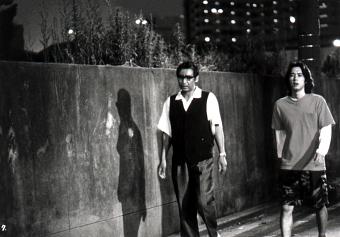 |
NINGEN
GOKAKU
Als Mensch zugelassen
Licence
to Live
Kiyoshi Kurosawa
Japan 1998
Produktion: Daiei
Co., Ltd., Tokio Weltvertrieb: Tokuma International 1-1-16, Higashi Shimbashi,
Minato-ku,�Tokio 105-0002
Tel. (81-3) 357 38 100, Fax 357 38 145
Buch:
Kiyoshi Kurosawa
Kamera: Junichiro Hayashi
Musik: Gary Ashiya
Ton: Makio Ika
Schnitt: Masahiro Ohnaga
Darsteller: Hidetoshi Nishijima, Koji Yakusho, Shun Sugata
Sprache: Japanisch
Format:
35mm, 1:1.85, Farbe Länge: 109 Minuten, 24 B/sek. |
| Yutaka
Yoshii hat zehn Jahre im Koma gelegen, nachdem er von einem Auto angefahren
worden war. Mit vierundzwanzig Jahren wacht er plötzlich auf und
muß feststellen, daß seine Familie nicht mehr zusammenlebt.
Als Yutaka das Krankenhaus verläßt, sieht sich Fujimori, ein
Freund seines Vaters, vor die Aufgabe gestellt, sich seiner anzunehmen.
Verwirrt und unglücklich über diese neue Situation, beschließt
Yutaka, den Pony-Reithof wiederzueröffnen, den seine Familie in seiner
Jugend betrieben hatte… Anhand der Geschichte dieses jungen Mannes
entfaltet Kurosawa eine ganz eigene Sicht auf die ‘condition humaine’
und familiäre Beziehungen. Der Film entwickelt ein langsames, bedächtiges
Tempo und verwendet Dialoge nur sparsam. Das Thema findet seinen Ausdruck
in einer kunstvollen Bildsprache, während sich die Geschichte vom
Leben und Tod des jungen Mannes auf der Leinwand abspielt. Es gelingt
dem Regisseur, das Publikum in seinen Bann zu ziehen und mit den Figuren,
den Familienmitgliedern und ihrer ungewöhnlichen Situation mitfühlen
zu lassen. Obwohl es sich nicht um einen phantastischen Film handelt,
haben seine Handlung und sein Stil etwas Exzentrisches. Die Figuren finden
nach langer Zeit wieder zueinander, und es entsteht sogar die Hoffnung,
daß die zerrüttete Familie eines Tages wieder zusammenleben
könnte. |
Yutaka Yoshii has been in
a coma for ten years after being hit by a car. At the age of twenty-four,
he suddenly wakes up. He discovers that his family is no longer together.
His father Shin’ichiro, his mother Sachiko, and his sister Chizuru
are all living separately. When Yutaka leaves the hospital, his father’s
non-conformist friend Fujimori finds himself with the unexpected responsibility
of taking care of his friend’s son. Perplexed and uncomfortable
in his new situation, Yutaka decides to reopen the pony stables that
his family once operated on their property when Yutaka was younger.
Kurosawa expresses a unique view of the human condition and family relationships
through the story of a young man who awakens from a coma after ten years.
The film is characterized by slow, careful pacing and minimal dialogue.
The theme is expressed through skillful use of visual images, as the
young man’s tale of life and death unfolds on screen. The film
is able to draw the audience into the story and makes it feel a sense
of empathy with the characters, the family members, and their unusual
family situation. Although the film is not a fantasy, its story and
style are somewhat fanciful. When the characters in the film reunite
after such a long time, and hope is held out that the dysfunctional
family can once again go back to being a true family, we are both moved
and fully involved with their plight.
|
Biofilmographie
/ Biofilmography
Kiyoshi Kurosawa wurde am 19. Juli 1955 geboren. Er studierte
Soziologie an der Rikkyo-Universität in Tokio. Seine ersten Filme
drehte er am College mit einer 8mm-Kamera. Nachdem er eine Zeitlang als
Regieassistent gearbeitet hatte, führte Kurosawa 1983 zum ersten
Mal Regie in einem Werbefilm mit dem Titel Kandagawa Wars. Seine Bekanntheit
wuchs mit Filmen wie The Excitement of the Do-Re-Mi-Fa Girl und The Guard
From the Underground. 1992 erhielt er für sein Drehbuch Charisma
ein Stipendium vom Sundance-Institut und reiste in die USA, um Film zu
studieren. 1997 schrieb und inszenierte er Cure. Born on July 19th, 1955,
Kiyoshi Kurosawa is a graduate of the sociology department
of Rikkyo University, Tokyo. He began filmmaking in college with an 8mm
camera. After working as an assistant director, Kurosawa made his debut
as a commercial film director in 1983 with Kandagawa Wars. His popularity
increased with such films as The Excitement of the Do-Re-Mi-Fa Girl and
The Guard From the Underground. In 1992, Kurosawa was awarded the Sundance
Institute Scholarship for his original film script Charisma and travelled
to the United States to study filmmaking. In 1997, he wrote and directed
Cure.
Films / Filme
1985: Doremifa Musume no Chi wa Sawagu (The excitement of the Do-Re-Mi-Fa
Girl). 1989: Sweet Home; Yatsura ha Konya mo Yattekita. 1992: Jigoku no
Keiibi-in (The Guard from the Underground). 1995: Katteni Shiyagare!!
Goudatsu Keikaku. 1996: Katteni Shiyagare!! Ougon Keikaku; Door III; Katteni
Shiyagare!! Narikin Keikaku. 1997: Fukushu - Unmei no Houmonsha; Cure.
1998: Hebi no Michi (Serpent Path); Kumo no Hitomi (Eyes of the Spider);
NINGEN GOKAKU. In Vorbereitung: Charisma. |